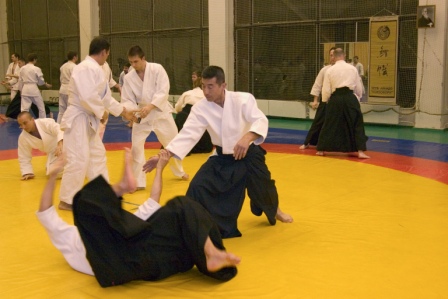A four-dimensional unity
Each seminar Seki sensei teaches in Moscow is, first and foremost, an event for which of us starts preparing long before it actually begins. Strictly speaking, right from the day when the previous seminar is over.
This is a familiar feeling: we have just said good-bye, having finished the last class of the seminar, and, over the regret of the days which have passed so quickly (maybe the speed of time changes in these days?), over the delight of new understanding of certain aspects, there arises the thought: When is the next seminar? What is it going to be like?
This seminar of November 2006 is very special.
First, because it is an anniversary: the 15th anniversary of Koinobori Dojo and 10 years from the time Seki sensei first came to Russia on the Dojo’s invitation.
Second, because the seminar has been perfectly organized. Even though there were multitudes of people eager to take part in the seminar, the organizers limited the number of people present at each practice based on the size of the dojo. 110 people – and not a man more. And that is understandable: in a thick crowd of people, even if they are of the most friendly disposition possible, it is impossible either to avoid injuries, or to work at the techniques with due diligence. Certainly, due to this quantitative restriction not everybody managed to visit as many classes as he or she wanted, but from the point of view of quality, I believe it is better to practice four classes with a space sufficient to take ukemi, than eight classes which are so crowded people are standing shoulder to shoulder.
Fine organization was felt in every little detail, so unnoticeable when they are there and so vitally important if they are absent. For example, signs indicating the route to dressing rooms and practice dojos – and in such an enormous sports complex as the “Trudovie Rezervy”, with its twelve floors, numerous gyms, hallways and corridors it is easy to get lost without such signs. Or the dojo finely decorated according to aikido tradition, even though we do not practice there regularly. Or, finally, inconspicuous but efficient registration of participants at each class – and at other seminars I have often seen huge lines slowly seeping through into the dojo with a turtle’s speed, because the people registration desk are taking long time looking through lists or stacks of participants’ cards.
Not a single slip regarding the time and place of the event – and that, I think, is very Japanese. Chronometric precision in implementation of plans is what delights every Russian in Japan and what we lack so much in our country. This time we did not lack it. It is hard even to imagine how much effort and stress it cost to the people from our Dojo who did the organizational work at the seminar.
And, finally, a wonderful choice of memorable items. An anniversary brochure issued by the Dojo for the seminar – with a story of how, by whom and when everything was begun. And T-shirts with a special design dedicated to this seminar, which is an anniversary both for Koinobori Dojo and for all Russian participants of Seki sensei’s seminars. And an educational video prepared by Dojocho Marina Karpova and senior instructor Vadim Grachyov.
Third, and most important, – because this seminar was truly exceptional in terms of its contents. Maybe in previous years I lacked the necessary concentration, experience and simply physical power to see the seminar as a great single whole.
This time I managed it, although certainly not in full.
Maybe this great whole is only a microscopic part of the way of aikido, walked in these several cold days in Moscow. But it is a whole – a message which Seki sensei brought for all of us this year.
Such a four-dimensional unity – also in the space of movements and in the time of the seminar. When the very first practice starts with katatedori kokyuho omote. The second one, the following morning – the same kokyuho, but already both omote and ura. The third – morotedori kokyuho omote and ura. The next – tehcninage omote. Then – ryotedori kokyuho. And that is only the first technique of each practice.
All the techniques that follow are also connected. At each practice we seemed to go over what we had done at the previous one, but rather than simply reviewing it made a step forward. Or down – to hanmi handachi or suwari waza. Seki sensei even reminded everybody: in yesterday’s technique we paid attention to this, and the same principle works here. Reminded by movement rather than by words, but did not spare the explanations either, when they were necessary.
Undoubtedly, the main result of the seminar is yet to come. When at practice we recall the feeling received at the seminar, when instructors explain to us things that we did not manage to perceive, to feel during the seminar, when once unfamiliar movements become natural and logical. That will be later. And now – I am simply sorry the seminar has ended so quickly. And I am grateful – to Seki sensei, to Dojocho Marina Karpova, and to all the members of Koinobori Dojo.
Zagorodniaya Elena (1 Kyu)
Koinobori Dojo, 18.11.2006

